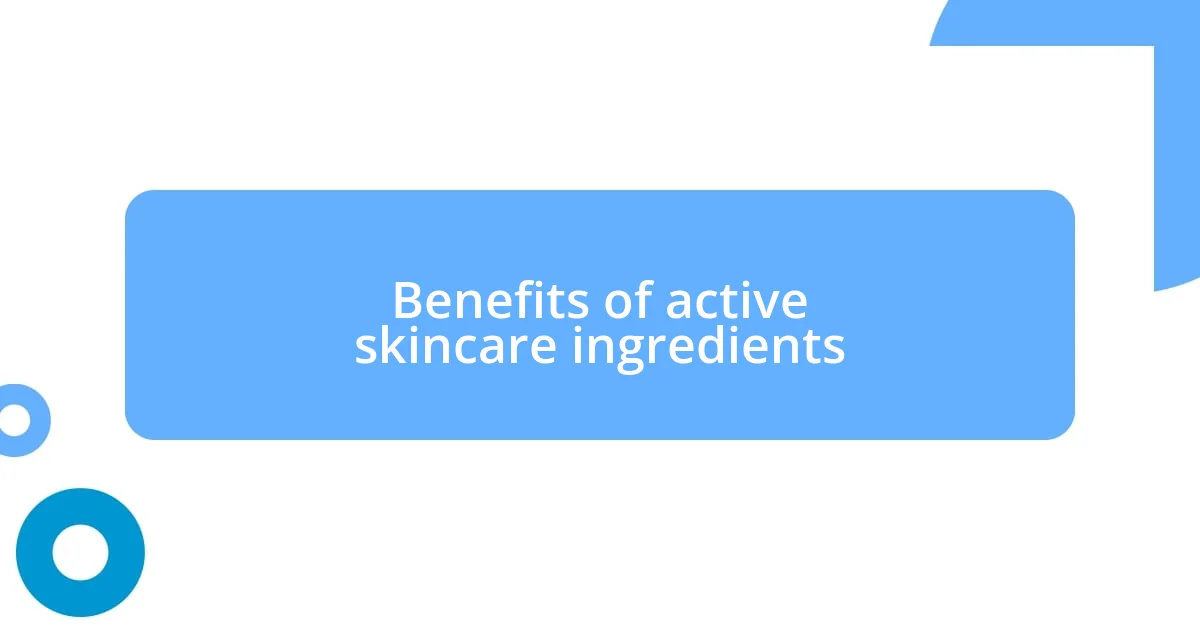Key takeaways:
- Understanding skincare ingredients empowers better skin care choices by revealing the specific benefits of each component, such as hydration from hyaluronic acid and brightening from niacinamide.
- Active ingredients play a crucial role in targeted skincare routines, with benefits like addressing specific concerns, enhancing results, and promoting faster skin renewal.
- Reading ingredient labels carefully is essential; the order of ingredients indicates concentration, and avoiding vague terms can prevent irritation from harmful components.

Understanding skincare ingredients
Understanding skincare ingredients can feel a bit overwhelming at first. I remember standing in front of a shelf full of products, each boasting a long list of ingredients that all sounded like they belonged in a chemistry lab. Have you ever felt the same way? It’s normal to feel lost, but taking the time to decode these labels can lead to healthier skin choices.
When I began diving into the world of skincare, I quickly learned that not all ingredients are created equal. For instance, while hyaluronic acid is a hydration powerhouse, retinol can be a game-changer for anti-aging. I still recall the first time I used retinol; a few weeks in, I started noticing smoother skin. It was a small victory that motivated me to learn even more!
As I explored, I found that understanding the purpose behind each ingredient transformed my skincare routine. Knowing that niacinamide helps to brighten and even out skin tone gave me a whole new appreciation for it. It’s amazing how a little knowledge can empower you, isn’t it? Each ingredient tells a story, and I encourage you to learn those stories for your own skin’s benefit.

Common skincare ingredient categories
Common skincare ingredients can typically be categorized into a few main groups, each serving distinct purposes for our skin. Moisturizers, for instance, include ingredients like glycerin and hyaluronic acid that draw moisture to the skin and help maintain hydration. I remember my excitement when I discovered how glycerin can create a little moisture lock, making my skin feel plump and dewy.
Another common category is active ingredients, which often target specific skin concerns. For example, acids like salicylic or glycolic acid can tackle acne and signs of aging, respectively. I still have vivid memories of my first routine overhaul when I introduced glycolic acid—it felt like I was revealing a brighter, fresher layer of skin!
Lastly, let’s not forget the soothing ingredients. Ingredients like aloe vera and chamomile calm irritated skin and provide relief from inflammation. I once tried a mask with chamomile after a long day in the sun, and the cooling effect was incredibly refreshing. These categories help us navigate the complex world of skincare by highlighting the diverse roles ingredients play in achieving healthy skin.
| Category | Key Ingredients |
|---|---|
| Moisturizers | Glycerin, Hyaluronic Acid |
| Active Ingredients | Salicylic Acid, Glycolic Acid |
| Soothing Ingredients | Aloe Vera, Chamomile |

Benefits of active skincare ingredients
Active skincare ingredients are the stars of any effective skincare routine. They each have unique benefits that can significantly improve your skin’s health. I remember my thrill when I first incorporated vitamin C into my regimen. It was like flipping a switch; my skin immediately looked brighter and felt more vibrant. Those transformative effects are what keep me excited about learning more.
Here are some key benefits of active skincare ingredients:
- Targeted action: They effectively address specific concerns like acne, wrinkles, or pigmentation.
- Enhanced results: Consistent use can lead to noticeable improvements over time.
- Faster skin renewal: Ingredients like exfoliating acids speed up the skin’s natural shedding process, revealing a fresh complexion.
These active ingredients not only bring immediate gratification but also long-term benefits that foster a deeper appreciation for skincare. It’s rewarding to witness the positive changes they bring with consistent use.

How to read ingredient labels
When it comes to reading skincare ingredient labels, understanding the order of ingredients is key. Ingredients are listed from highest to lowest concentration, so the first few on the list are what you’ll find in the largest amounts. I remember sifting through products at the store, scanning labels for familiar names and feeling a mix of excitement and confusion—was that ingredient truly beneficial or just a fancy term?
Another essential tip is to look for specific terms and avoid vague phrases. For instance, if a moisturizer claims to be “fragrance-free,” verify that it doesn’t contain “parfum” or “fragrance” in its ingredients—sometimes, manufacturers can be sneaky! During my early skincare journey, I learned this the hard way after trying a supposedly gentle cream that left my skin feeling irritated. It was a frustrating experience, but I needed to gather that wisdom to make informed choices in the future.
Lastly, pay attention to potential irritants. Ingredients like alcohol or certain essential oils can be problematic for many people, including myself. One night, I decided to try a trendy toner with high alcohol content, eager to have that tingly sensation—it turned out to be a terrible mistake! My skin reacted with redness, and it became a valuable lesson on how deeper understanding of ingredient labels can help prevent such mishaps. So, what’s your experience with ingredient labels? Are there specific products that you wish you had read the label on first?












